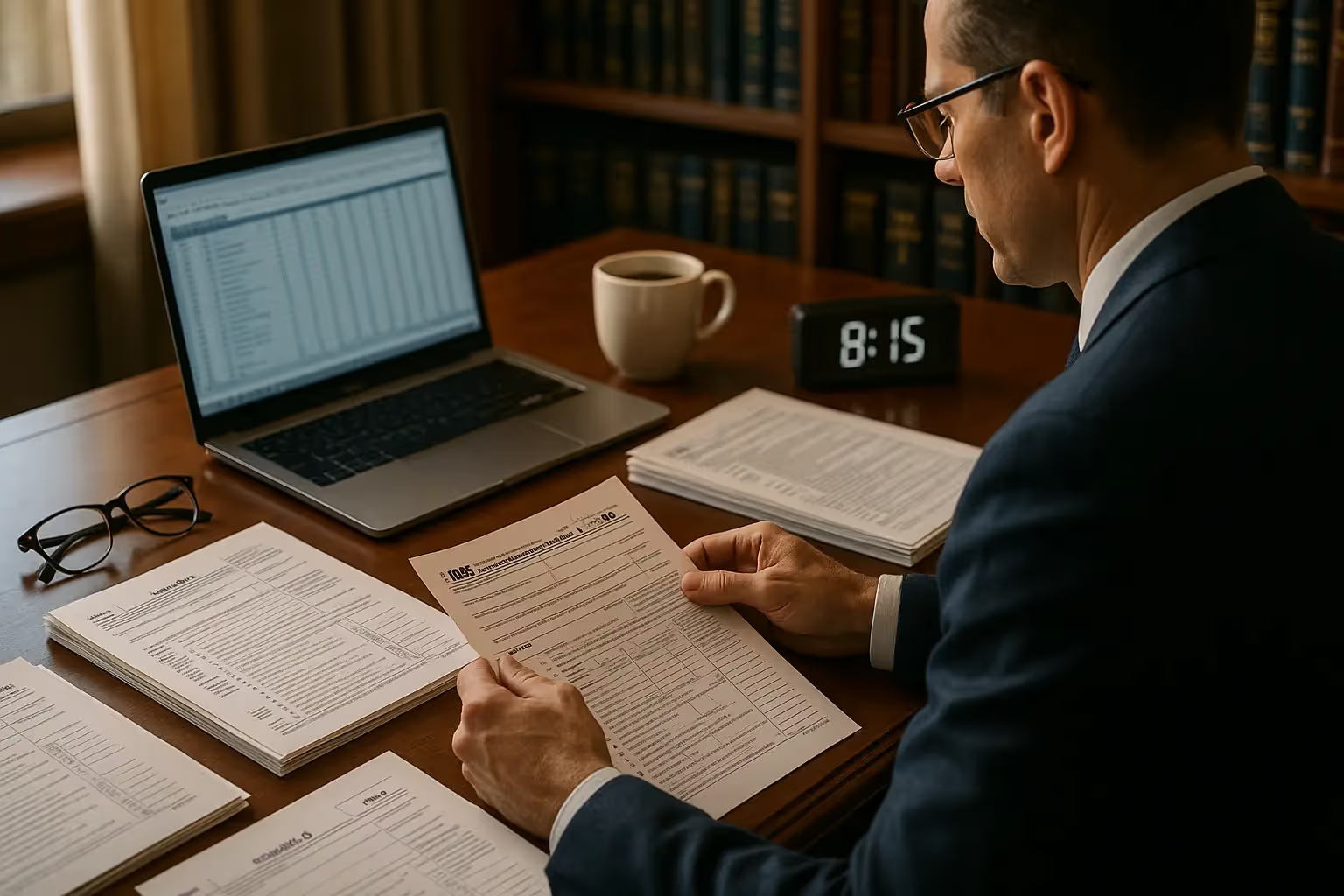Unfiled 2014 Form 945: How to File, Penalties, and Relief Options

An unfiled 2014 Form 945 can cause years of IRS complications that continue until the return is submitted. The IRS treats withheld federal income tax as trust funds, making noncompliance especially serious. Leaving the annual return unfiled triggers immediate enforcement actions. Delays increase scrutiny and expose businesses or individuals to escalating consequences.
Unfiled returns create growing balances through penalties, interest, and unresolved federal tax obligations. The failure to file penalty quickly reaches 25 percent of the unpaid tax. Additional penalties apply for unpaid balances and late deposits. Daily compounding interest further inflates total tax liability over time.
This guide provides practical steps to file Form 945 for 2014 and reduce potential damages correctly. You will learn how to gather information returns and report backup withholding. We will explain penalties and their calculations in plain language. Finally, we present available resolution options for managing overdue federal income tax.
Understanding Form 945
Form 945 plays a unique role in the U.S. tax system because it ensures that nonpayroll withholdings are properly reported and paid. Many employers and businesses overlook its requirements, which leads to serious issues with the IRS. Below, we break down its purpose, differences from payroll forms, who must file, and the consequences of late filing. By understanding these points, you can avoid costly mistakes and unnecessary penalties.
Definition and Purpose of Form 945
- Annual Return of Withheld Federal Income Tax: Form 945 is the annual return used to report withheld federal income tax from nonpayroll payments.
- Purpose of the return: The form allows the IRS to track taxpayer obligations related to payments received outside of regular wages.
- Scope of reporting: It applies when businesses withhold taxes from independent contractors, annuities, pensions, or gambling winnings.
- Connection to law: The obligation comes from tax laws that require each person to report and deposit withheld amounts to the Treasury.
In short, Form 945 ensures that withheld amounts are properly remitted, protecting both the government and the taxpayer.
Difference From Payroll Tax Forms
- Nonpayroll vs. payroll: Unlike a wage and tax statement, Form 945 focuses on nonpayroll obligations, such as nonemployee compensation.
- Form 941 comparison: Payroll forms like 941 cover Social Security and Medicare taxes for employees, while Form 945 does not.
- Focus of reporting: It specifically targets backup withholding tax and other federal taxes outside wages.
- Example of application: A corporation paying contractors must file information returns and Form 945 to show withheld amounts.
This difference matters because confusing payroll and nonpayroll obligations can lead to filing errors and IRS penalties.
Who Must File Form 945
- Businesses with nonpayroll obligations: Any employer withholding federal income tax from pensions, annuities, or gambling winnings must file Form 945.
- Independent contractor payments: When nonemployee compensation is subject to withholding, the taxpayer must report it on this tax return.
- Backup withholding requirements: Backup withholding applies when a taxpayer identification number (TIN) or social security number is missing or incorrect.
- Information reporting link: If you file information returns like 1099s, you must often complete Form 945 to reconcile those withholdings.
Anyone who withholds nonpayroll taxes is a responsible person under IRS regulations and must comply with this filing obligation.
Consequences of Not Filing Form 945
- Failure to file: An unfiled 2014 Form 945 creates ongoing failure issues that the IRS continues to track.
- Penalties and interest: The IRS imposes penalties for willful neglect, errors, or late filing, and interest accrues on unpaid balances.
- Increased liability: A business can quickly build significant tax liability that exceeds the original paid taxes.
- IRS notices: The IRS will notify the taxpayer with a notice demanding payment, creating stress and potential legal complications.
Failing to submit the annual return on time leaves the taxpayer liable for penalties and collections until the account is resolved.
Step-by-Step Filing Instructions for the 2014 Form 945
Filing an unfiled 2014 Form 945 requires careful preparation because the IRS enforces strict rules for accuracy and compliance. Below are the essential steps every taxpayer must follow to complete the process correctly.
- Gather required documentation: Collect all information returns, such as 1099-R, 1099-MISC, and W-2G, reflecting payments made during 2014.
- Confirm filing obligation: Determine if you must file Form 945, even if the withheld federal income tax occurred only once in the tax year.
- Complete the form line by line: Enter the total federal income tax withheld, report any backup withholding, and calculate the total tax liability owed.
- Prepare mailing package: Send the completed tax return to the correct IRS address based on your business location and whether a payment is included.
Following these steps ensures you properly complete Form 945, avoid additional penalties, and resolve any outstanding federal tax obligations with the IRS.
Accessing the Correct IRS Forms and Instructions
The right version of Form 945 is critical for accuracy because the IRS strictly enforces prior-year rules. Taxpayers who rely on the wrong form risk misreporting, rejection, or penalties. Below are the essential points you need to know when handling the 2014 version of Form 945.
Importance of Using the 2014 Version
- Compliance with prior-year rules: The 2014 version of Form 945 must be used because IRS tax laws change from year to year.
- Accuracy of reporting: Submitting a current-year tax return for an old obligation can create errors in federal tax calculations.
- Correct tax liability reporting: Only the official 2014 version captures the right federal income tax tables and rules.
- IRS requirements: The IRS imposed clear regulations that taxpayers must follow when filing Form 945 for prior years.
Always confirm the correct year before filing because prior-year forms protect against mistakes in reporting and compliance.
Where to Find Archived IRS Forms
- IRS official website: The IRS hosts archived forms and tax information for every year in its prior-year forms library.
- Locate Form 945: You can download the 2014 Form 945 and its instructions directly from the IRS.gov forms and publications page.
- Access instructions: The 2014 instructions explain how to complete Form 945, including reporting withheld federal income tax and backup withholding.
- Supporting data: Taxpayers may also download related information returns and other tax statement references needed for accurate filing.
Using official IRS sources ensures you have the most reliable and legally valid tax information for your filing.
When Form 945-A Is Required
- Threshold for filing: You must complete Form 945-A if your tax liability for 2014 exceeded $2,500.
- Purpose of the form: This schedule allows the IRS to track various types of deposits by date, showing monthly payment obligations.
- Detailed reporting: It ensures accurate reporting of deposits for federal tax withheld, including backup withholding tax.
- IRS review: By requiring this form, the IRS can verify that taxes were deposited correctly and on time.
Form 945-A is essential for businesses with larger balances because it provides the IRS with detailed monthly compliance records. Accessing the correct IRS forms is not optional but a necessary part of proper tax compliance. By using the official 2014 Form 945 and supporting instructions, and filing a Form 945-A when required, you protect your business from errors, penalties, and unnecessary IRS scrutiny.
IRS Penalties and Interest for Late Filing
When a taxpayer leaves an unpaid IRS return, the penalties and interest can escalate quickly. The IRS enforces these charges separately, and they can accumulate until the balance is fully resolved. Below are the main categories of penalties and interest that apply to an unfiled 2014 Form 945.
- Failure to file penalty: The IRS charges up to 25 percent of the unpaid federal income tax when a taxpayer misses the filing deadline.
- Failure to pay and deposit penalties: The IRS adds charges for late payment and missed deposits, increasing the total tax liability.
- Penalties on backup withholding: The IRS imposes penalties separately on backup withholding and other balances tied to information returns.
- Daily compounding interest: The IRS calculates interest daily on unpaid federal tax, which makes long-term costs grow significantly over time.
These penalties and interest charges highlight why immediate filing and payment of Form 945 are essential to avoid long-term financial damage.
Trust Fund Recovery Penalty
The Trust Fund Recovery Penalty (TFRP) is one of the IRS’s most severe enforcement tools. It applies when a business fails to pay overheld federal income tax from nonpayroll or payroll obligations. The withheld amounts are trust funds because they belong to employees or payees, not the business. When unpaid, the IRS enforces this penalty to protect the Treasury from lost tax revenues.
The IRS can hold specific individuals personally responsible for unpaid tax liability tied to nonpayroll withholdings. A responsible person may include an owner, officer, bookkeeper, or anyone with authority over payments received and distributed. If the IRS proves willful neglect or intentional failure to comply, liability shifts to the individual. This means the person becomes liable for the withheld federal tax as though it were their obligation.
The IRS follows a structured process when assessing the Trust Fund Recovery Penalty. An investigation starts with a revenue officer conducting interviews and reviewing records. The IRS issues a notice of proposed assessment, allowing the individual to respond or appeal. If the issue is unresolved, the penalty is assessed, and the individual’s account reflects the debt, subject to collection and enforcement actions.
Resolution Options for 2014 Form 945 Issues
When a business or taxpayer has an unfiled 2014 Form 945, the IRS provides several paths to resolve the outstanding balance. These options can help manage overdue federal tax obligations, reduce penalties, or pause collection activity. Below are the primary resolution strategies for addressing this tax problem.
Installment Agreements for Federal Tax Balances
- Monthly payment flexibility: An installment agreement allows taxpayers to pay overdue taxes in smaller, manageable monthly amounts.
- Short-term arrangements: Short-term agreements help settle federal tax balances within 120 days without a setup fee.
- Long-term arrangements: Long-term agreements allow larger balances to be spread over years, though interest and penalties continue.
- IRS approval: The IRS may require financial records or a request using Form 9465 to establish eligibility.
An installment agreement helps taxpayers avoid immediate enforcement while complying with IRS requirements.
Penalty Relief Options
- Reasonable cause relief: The IRS may grant relief if the taxpayer shows reasonable cause for late filing or payment.
- Failure to file relief: Relief may apply if the taxpayer can demonstrate that the failure to file was not due to willful neglect.
- First Time Abate: Taxpayers with a clean history for the following year and prior years may qualify for a one-time penalty waiver.
- Supporting evidence: Taxpayers must provide documentation, such as tax statements, medical records, or other relevant details, to support their claim.
Penalty relief can significantly reduce costs but requires strong documentation and timely communication with the IRS.
Offers in Compromise (OIC)
- Settle for less: An OIC allows taxpayers to resolve their tax liability for less than the full amount owed.
- Eligibility criteria: The IRS considers an OIC only if the taxpayer cannot fully pay based on data and records.
- Application process: Taxpayers must submit detailed financial forms, including proof of payments received, contracts, and asset valuations.
- IRS discretion: Approval is not guaranteed, and the IRS carefully reviews whether acceptance is in the government’s best interest.
An Offer in Compromise is best suited for taxpayers facing significant financial hardship who cannot realistically pay the full debt.
Currently Not Collectible (CNC) Status
- Temporary relief: CNC status stops IRS collection actions when taxpayers prove they cannot meet basic living obligations.
- Financial proof required: The taxpayer must provide records, statements, and evidence that the payments would cause hardship.
- Debt remains: The IRS still records the balance and continues to add interest, even though collection is paused.
- Periodic review: The IRS regularly reassesses CNC cases to determine if the taxpayer’s ability to pay has changed.
The Not Collectible status currently provides breathing room but does not erase debt or eliminate long-term responsibility. The IRS offers multiple resolution options to help taxpayers address unfiled 2014 Form 945 problems. Choosing the right option depends on the taxpayer’s financial situation, compliance history, and ability to provide accurate documentation. By taking prompt action, taxpayers can prevent further IRS enforcement and move toward resolving their outstanding obligations.
Final Steps and Best Practices
Resolving an unfiled 2014 Form 945 requires immediate action, but lasting compliance also depends on smart planning. These best practices will help minimize penalties, reduce stress, and establish stronger systems for the future.
- File overdue annual return immediately: Submit the overdue annual return without delay to stop additional penalties and interest from increasing your outstanding federal tax balance.
- Seek professional assistance: Consult a tax professional for complex federal tax cases involving Form 945 to ensure accurate compliance and strong representation with the IRS.
- Establish compliance systems: Implement internal processes for the timely filing of information returns and accurate reporting of federal income tax withheld to avoid repeated issues.
Taking these steps not only resolves your current problem but also protects your business from costly penalties and unnecessary IRS scrutiny in the future.
FAQs
Can I still file Form 945 for 2014 even though it’s over 10 years late?
Yes, you can still file Form 945 for 2014 even after more than ten years. The IRS does not impose a statute of limitations on filing an unfiled return. Penalties and interest will accumulate until you file and pay what you owe. Filing now is always better than leaving the return unfiled because it can prevent further enforcement actions.
What happens if I can’t find all my 2014 information returns?
If you cannot locate all your 2014 information returns, you should reconstruct records using available bank statements, contracts, or accounting data. The IRS also provides wage and income transcripts that may show 1099s and other forms filed under your EIN. Reasonable estimates backed by documentation are generally acceptable if complete data is unavailable. Acting in good faith by filing promptly with the best information reduces the risk of harsher penalties.
How do I know if I’m subject to penalties for backup withholding?
You may face backup withholding penalties if you paid contractors or payees who provided an incorrect TIN. The same applies if you failed to withhold federal income tax when required under backup withholding rules. IRS notices often alert businesses to these issues when mismatches occur. Penalties and backup withholding obligations may apply if you filed information returns with missing or incorrect TINs.
Can failure to file penalties be waived after so much time has passed?
Yes, the IRS may still waive failure-to-file penalties even after many years. Relief is possible through reasonable cause arguments or the First Time Abate program if your prior history is clean. You must provide evidence showing circumstances like serious illness, natural disasters, or inability to access records. While penalties may be reduced, interest on unpaid balances usually continues until the full liability is resolved.
What’s the difference between Form 945 and Form 941?
Form 945 reports annual nonpayroll withholdings such as pensions, annuities, and gambling winnings. Form 941, by contrast, reports payroll-related federal income tax, Social Security, and Medicare withheld from employee wages, filed quarterly. Businesses with both employees and nonemployee contractors may need to file both forms. Mixing the two creates compliance issues, so each form must be filed correctly to match the specific type of withholding obligation.


.avif)


.avif)














































































